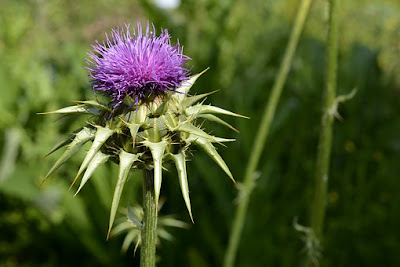Scientific name: Annona muricata var. subonica
Other names: guanábana, guanavana, guyabano, graviola, custard apple, Brazilian pawpaw, durian benggala, nangka blanda, nangka londa, mullaatha.
Description:
Soursop or Guyabano is a fruit-bearing tree that is native to Central America, Caribbean, South America and sub-Saharan African countries. It is also grown in parts of Southeast Asia. Guyabano is just a small evergreen tree of usually about 5 to 7 meters high. The leaves are oval-shaped, pointed on both ends and with smooth, shiny texture. The flowers are large white or yellow or greenish-yellow that bloom all year round and emits a pleasing scent.
The fruit of the soursop (guyabano) is green, obviate, pear or heart-shaped and covered with soft spines. It has thin skin and the fibrous edible pulp is soft & whitish with sweet-sour citrusy flavor. The black, hard seeds
inside taste awful and are indigestible. The guyabano pulp is usually eaten ripe or made into juice, smoothies,
sorbets or ice cream.
Parts used: Fruit; Leaves
Health Benefits:
Soursop is one of the healthiest fruits available to us. It has high amounts of Vitamin C, Vitamin B1, Vitamin B2, potassium, phosphorus, iron and dietary fiber. Because of the presence of these vitamins and minerals,
guyabano(soursop) is known to have lots of health benefits, it is a potent antioxidant and it enhances the immune system.
Medicinal properties:
Traditional medicine have used not only the fruits of the guyabano/soursop but also the bark, leaves, roots,
flowers and seeds to treat many ailments like asthma, wounds, infection, eczema, inflammation, arthritis,
rheumatism, heart disease, liver problems, wounds, stomach spasm, dysentery, scurvy, hematuria, urethritis and
even to remove head lice.
~Guyabano seeds (pulverized)
*It is toxic and is for external use only
*The seed oil is used to purge parasites and kill head lice. It is also used as a skin astringent.
~Guyabano leaves (minced and boiled)
*Treatment for eczema and skin diseases (poultice of mashed leaves and sap applied directly on skin)
*Used as wet compress to treat pain and inflammation of the joints like arthritis, rheumatism
*Treatment of pimples (The sap of the young leaves may be applied directly)
*Treatment of fever (decoction of leaves taken internally)
*Tranquilizing and sedative properties (Drinking boiled guyabano/soursop leaves may help induce sleep)
~Guyabano fruit (juice/shake or smoothie)
*The guyabano fruit is diuretic and can treat dysentery, scurvy, hematuria and urethritis
~Guyabano bark, roots and leaves (minced and boiled)
*To treat diabetes
*Tranquilizer and sedative
~Guyabano leaves and roots
*Treat colic and convulsions
1.
Anti-Cancer
Annonaceous acetogenins are the compounds found in Guyabano extract that has the ability to inhibit the enzyme processes and the growth of malignant cells. It is known to kill the different types of cancer cells found in colon, pancreatic, liver,lung, breast, ovarian, cervical, prostate cancer and lymphoma. Researched showed that this compound is many times stronger in killing cancer cells than the commonly used chemotherapy drug. And unlike chemotherapy which can harm the healthy cells, Soursop or Guyabano can kill these malignant cells without damaging the healthy cells.
How to make Guyabano Tea:
Boil 1 liter of water.
Add 1 cup of shredded air-dried guyabano leaves (air dried guyabano leaves have more medicinal properties than
fresh leaves).
Turn down the heat and let it simmer for 20 minutes.
Drink within 7 hours after making the tea to benefit from its medicinal properties.
30-3-30 Rule
It is best to drink it 30 minutes before mealtime.
Taken 3 times a day.
For 30 consecutive days.
To get the full benefit of the treatment.
For maintenance, drink one glass for 5 consecutive days then stop for 2 days then resume drinking for 5 days.
Repeat the process. You may taper it when the cancer cells are gone.
2.
Good for the Liver
Guyabano enhances production of endogenous antioxidant that is beneficial to hepatic tissues.
3.
Anti-Depressant
Guyabano contains compounds like annonaine, nornuciferine and asimilobine that possess anti-depressive effects.
Cautions and Adverse Effects:
Internal consumption of the concoctions of leaves, seeds and barks are not recommended for young children, pregnant and lactating women.
The annonacin content is a neurotoxin associated with neurodegenerative disease and might be linked to the
development of atypical Parkinson's disease. Thus taking guyabano in large doses is not recommended for people with suspected Parkinson's disease and those with motor control problem.
The hydrocyanic acid found in leaves can be harmful when taken in high concentrations.
THOUGH THE CONTENT OF THIS BLOG HAD BEEN TRIED/TESTED AND HAD BEEN USED
AS FOLK/HERBAL MEDICINE IT IS STILL BEST TO CONSULT YOUR DOCTOR BEFORE
TRYING THIS AND AVOID SELF-DIAGNOSIS AND SELF-MEDICATION.































